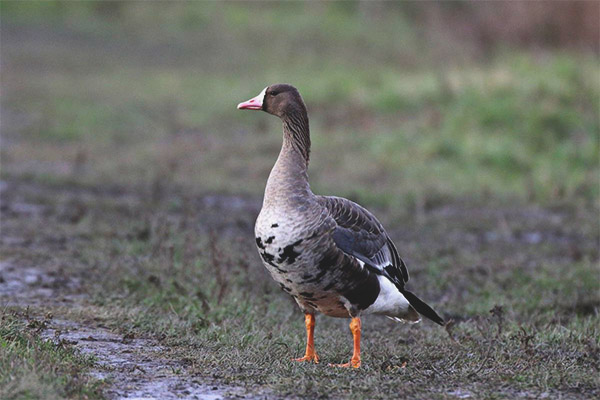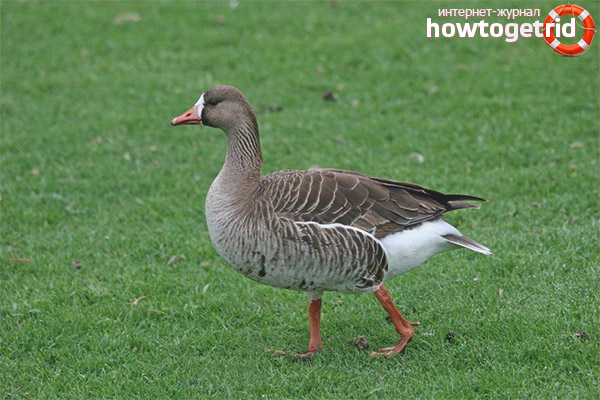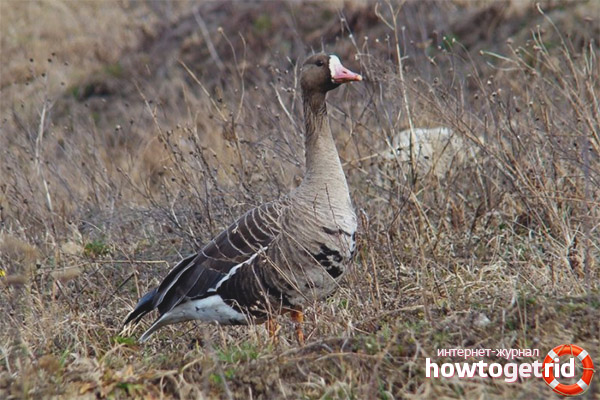The content of the article
Hunting birds is gaining increasing popularity. In view of which the number of feathered individuals decreases over time. Today we look at a representative of the goose family, namely the white-fronted goose. It differs from the rest of its fellow size and taste. Hunters are not averse to eat poultry harvested by their own labor.
Habitat
In the process of finding a place to build a dwelling, individuals are guided by the fact that there is a reservoir or other similar source nearby. Natural waters with dense vegetation that are not in a wooded area, this is all that birds need.
Usually geese are found in swampy lands, near valleys with reservoirs, rivers, lakes. These individuals successfully breed in different parts of the globe, be it Asia, Europe, Greenland or America.There are American species of similar birds that have settled in Alaska and Canada.
Birds are sent for wintering in the Mediterranean countries, as well as the Black Sea. They fly there annually, as soon as it gets cold enough in their native lands.
When cold weather sets in at home, birds travel to warm regions such as Asia or Hindustan. They are met in the south and east, on the Caspian Sea. North American feathered friends do not leave the territory of their country, shifting except in its southern regions.
Description
According to its external characteristics, this representative of the family is similar to the gray goose. However, in terms of overall features, the case is smaller. The birds are brown in color, in the area of the belly one can observe black markings.
The beak is famous for its pinkish tint, very much in harmony with the rest of the coloring.On its surface one can observe the whiteness mark. The young do not have such points, after maturing they will appear. This usually happens in a couple of years. In parallel, the abdominal region brightens, the frontal section is highlighted.
Paws are orange with a reddish tint. The tail includes special feathers, which are painted white. By its weight, the presented birds can reach 2-3 kg. This is the norm, possible deviations of + - 5 kg.
Lifestyle
- Individuals of this species belong to the category of migrants, that is, they are sent to winter where they are warmer. When the birds move, they try to keep to the lakes and large rivers. In these areas stop for the purpose of rest and reserve of forces. At night, they settle on a wide shoal or open meadows.
- In June, the birds begin to build housing for future offspring. As a rule, adults fly first, then young. The thing is that immature couples find it difficult to travel for a long time. They eat a lot at stops and recover for a long time. These birds move quickly over land and swim well.
- Considered individuals like winter and stubble. Often in the diet of birds and there are all sorts of berries, algae. Among other things, individuals feed on horsetail and plant roots are broken in.As soon as the birds end their summer molting process, they unite in flocks and try to feed all together.
- Often, such individuals begin to feed at sunset, when the sun is just beginning to set below the horizon. After the meal, the geese go to the watering place. At the end of the day, the birds return to their habitat for resting. Often during wintering individuals are placed on the fields. In such places there are usually cereals. Because of this, local farmers often chase birds.
Breeding
- The mating season and the corresponding games in birds begin during the flight. After arriving at the nesting sites, adult couples are already forming. Immature individuals keep in separate flocks. Therefore, the summer period they spend separately from couples. Single birds wander all this time before returning home.
- As soon as the geese reach their nesting sites, they begin to reproduce the offspring. Often individuals begin to build nests in elevated and dry places. In most cases, they are tubercles, hummocks and hillocks.On them, the birds make small depressions, which are covered with dry grass and down.
- For 1 time the female blows up to 6 eggs. It is followed by incubation. Nestlings begin to be born only in a month. The male, in turn, all this time trying to carefully protect the territory. If there is any danger, the gander always warns the female.
- After the young are born, they stay for a while with their families. At this age, goslings are already quite capable of hiding and getting food on their own. However, parents do everything for them and guard them well. Adults wait for their offspring to fully take care of themselves.
Facts about geese
- In places where the represented individuals often live, for quite a long time there has been a law that it is strictly forbidden to catch birds during shedding.
- Shooting is allowed only from firearms at a time when all individuals, including the young, are sent for wintering. It is for this reason that the number of geese is not under threat.
Considered geese are interesting individuals.Splitting into pairs, they begin to build their family. During the incubation of eggs, the male carefully protects the female. After the birth, the goslings remain in the family. Parents continue to protect them until such time as the youngsters will rise on the wing. However, even in this period, the older individuals try to protect their offspring from predators.
Video: White-fronted Goose - a note for hunters













To send